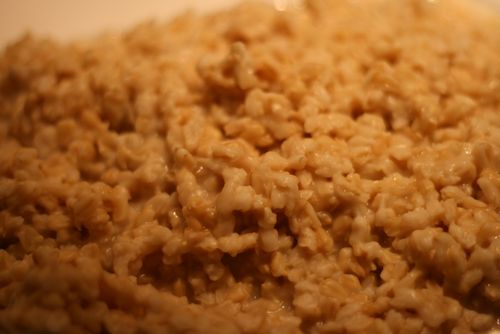Inspired by this post over at The Deliberate Agrarian, and also by my Sue Gregg Breakfasts cookbook, I decided to make some thermos oatmeal last night for breakfast this morning. I grabbed my two 32 oz. stainless steel thermoses out of a moving box (yes, we still have plenty of those unpacked around here), the bag of oat groats I got on sale at the local health food store, and a pan to boil water (still haven’t found the teapot). Using a 3.5:1 ratio, I put a cup of oat groats (whole grain oats) in each thermos, followed by roughly 3 3/4 cups boiling water (in each). I capped them, turned them on their sides, and went to bed. This morning, this is what the oats looked like:
Looks like oatmeal, yes? While this might not surprise you, that cooked oats looks like oatmeal, it surprised me. See, I have cooked oat groats and steel cut oats before, and while I loved them, they took forever to cook on the stovetop, and turned out delightfully nutty and slightly chewy. I really love that about them, but my kids prefer the mushier texture of oatmeal. And I prefer the cooking time of regular oats.
But this? Was so easy and fast. I boiled water (and my vintage GE electric coiltop stove boils water faster than any stove I have ever owned before), dumped it all in two thermoses, and was done. (Note to self: one thermos is enough for all four of us.) The texture is mushier like oatmeal, but still retains a little body, like steel cut oats. When we start using our fireplace insert, I can boil water in a teapot on top of that, saving even more money by cutting out the stove.
I’m encouraged. I wanted to buy a 50 lb. bag of organic oat groats when I place my bulk foods order this week, but I didn’t want to have to buy a grain roller/flaker to have oatmeal. Now I know that I don’t have to buy the flaker (though I kind of still want to).
Sue Gregg says you can cook just about any grain in a thermos for breakfast cereal. If you want to know more about this topic, just google “thermos cooking,” and you’ll come up with lots of links.


i read about this last week on another blog and have been thermos cooking my breakfast ever since.
Will you need a flaker (or roller) if you want to use the groats in baking (cookies, bread, etc?).
I’m still at the old fashioned oats stage, though groats sound interesting.
Erica, yeah, I’ll prolly need a flaker. Which is both good (I want one) and bad (they cost money). 🙂
ok, so i’m new to wordpress…obviously…how do i subscribe to yours & to Kate K.’s blog?
i’ve never used groats before. does this work with steel cut oats? or do you think that’s too mushy?
gracee, i’m going to email you on that one.
liz, this would work great with steel cut oats. it would probably work find with regular oats, too, since those end up mushy no matter how you cook them.
For extra taste, try toasting you steal-cut oats for a few minutes before putting them into your thermos.
They won’t stick to your thermos,all of it comes right out,and it makes your kitchen smell like a cookie.
Best way yet I’ve found.
Thank you for the instructions on how to cook oats using a thermos.
Prior to cooking, do you soak your oats overnight to remove the phytates? I have read that this antinutrient bonds with the minerals in the grain preventing absorption.
Have a great day,
Kurt
yes, ideally, you would soak for 24 hours before cooking. so two nights before you want to eat it, soak with some whole wheat flour (which has been shown to reduce phytates better than oats alone) until the next night. then drain, put oats in thermos, proceed as above.
i have to admit that i don’t do this. too much forethought required for this stage in my life. i do sometimes add whole wheat flour to the thermos, figuring that that helps reduce the phytate content even without the addiitonal day of soaking. (i think i’ve read you’re supposed to add 10% of the weight of oats in whole wheat flour.)